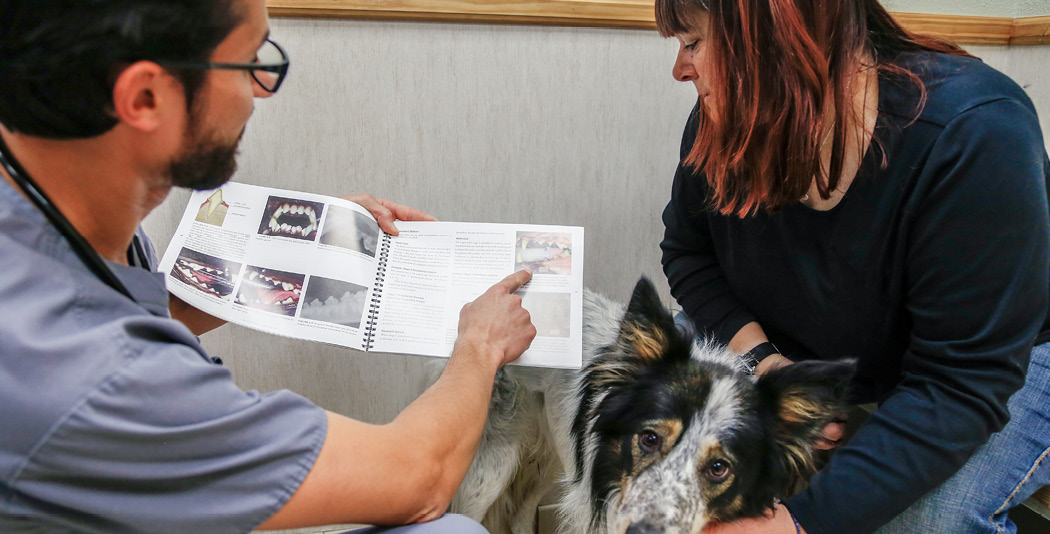Making It Stick
How to Improve Client Information Retention
by Stacee Santi, DVM

If you really want something to stick, tell a story about it. Use a fellow patient that struggled with the same situation or even something you heard about.
Within 1 hour, a person will forget 50% of what they were just told. Within 24 hours, they will have forgotten 70%. Within a week, they will have forgotten 90%. Houston, we have a problem.
I can’t begin to tell you how many times I have told a client something and they either (1) claim I never told them, or (2) totally screw it up. Sometimes, I have to repeat everything to the spouse (my personal favorite!). When I was a newer vet, I wondered why they weren’t understanding what I was telling them. But now I realize there are many things that affect a person’s ability to retain information, and if we know what they are, we can set ourselves up for success.
Personally, I consider myself a good listener, and I would say those stats don’t apply to me. But then this happened: I am currently learning Spanish. My goal is to become fluent in one year. In addition to the Babbel app and a workbook I bought on Amazon, I listen to stories on Spanish podcasts. One thing that I realized is that if I get hung up on a word or sentence, my brain freezes and tries to figure it out. While it is “stuck” the story keeps going and I get further and further behind until I have to stop and rewind. I wonder if this is what it is like for clients when we give them information and instructions?
But First, Neuroscience
Most people speak at 125–150 words per minute. For reference, an auctioneer speaks at about 200 words per minute. People can listen at about 400 words per minute, which means they easily get bored and distracted when they are supposed to be listening. They start thinking of other things or what they might say next and stop listening.
Now when it comes to the presenter (you, the clinician), most people think at 900 words per minute. But, if you are only able to speak at 125 words per minute, that means the first words to come out of your mouth have about an 11% chance of being what you mean to say. You’ve probably heard the phrase “Let’s talk through this.” That is because as you get going with your story or information, you start getting to the good part. Because our brains work this way, the best outcomes for our listener are driven by preparation of the speaker. Think of it as a movie you are about to show; the edited version is always best. Don’t let your dismissal be the four-hour version of Avatar.
Since we have two sides of the conversation, each responsible for their part, let’s look at strategies to optimize our listener, then our speaker.
Setting the Listener Up for Success
1. Decrease their stress
The more stressed the listener is, the less likely they are to understand what you are saying. Stress causes a number of challenges for the listener, such as distracted thinking. This can escalate to worst-case scenarios: overthinking, tongue stumbling (unable to form words), light-headedness, trouble thinking, and even a loss of touch with reality.

The more stressed the listener is, the less likely they are to understand what you are saying.
If your client is experiencing high levels of stress, then you need to delay communication until their stress level lowers. For example, you just told the client their dog has a large splenic tumor that is life-threatening. They start sobbing. This is not the time to discuss options. This is the time to provide support, even step out of the room if necessary, and allow them to calm down.
It’s easier said than done though, because they may start asking you lots of questions that they aren’t ready to handle. They will come largely in the form of, “Is he going to die?” or, “How much is this going to cost?” Recognize these are loaded questions and not questions you should actually answer at that moment. While the emotions are running high, you need to respond with comforting answers like, “We will do everything to prevent him from dying” or, “We have some decisions to make, and I will be helping you.” Whatever you do, do not give a quote at this moment. Realize they are emoting and you need to give them time to calm down.

Here are few other things you can do to lower their stress:
- Offer them a glass of water
- Ask if you can phone anyone for them so they can join for support
- Give them a hug (if appropriate)
- Let them see their pet if possible
- Give them a quiet space to cry (and make sure they have tissues)
Eventually all crying stops, and when it does, and you see they are breathing slower and talking better, you can start presenting the information. Believe me, if you cut this corner, you will be entering no-man’s land.
 Now, there is one exception to this rule, and that is when you have a critical time-sensitive situation, like a GDV, where you need an answer ASAP. I find that most people can pull it together in five to 10 minutes, but every now and then you will have a person who is just a wreck and can’t seem to listen. In these situations, I recommend using the emergency phrase “I need you to stop crying so we can make a decision now.” I’ve only had to say this a handful of times in my 20-year career, but when necessary, it works like a charm.
Now, there is one exception to this rule, and that is when you have a critical time-sensitive situation, like a GDV, where you need an answer ASAP. I find that most people can pull it together in five to 10 minutes, but every now and then you will have a person who is just a wreck and can’t seem to listen. In these situations, I recommend using the emergency phrase “I need you to stop crying so we can make a decision now.” I’ve only had to say this a handful of times in my 20-year career, but when necessary, it works like a charm.
2. Invite them to record the conversation
The Voice Memo app is an amazingly helpful tool when you want to capture a conversation. My parents use this at the doctor’s office so we can listen to it together again. That way when I ask Mom, “What is the exact medication they are injecting into your eyeball?” I can get the information versus, “I’m not sure, sweetie.” Remind them this will be a great way to review the information later or share with their significant other in case they forget. (Heads-up—most people, such as moi, consider themselves excellent listeners, but in reality, we all pretty much suck.)
3. Ask them to put their phone in silent mode
Getting a text message ding in the middle of an important conversation is like shocking a dog with a shock collar. It immediately disengages the listener. It is unavoidable.
Do remember after the conversation is over to remind the client to turn their sound back on. They will appreciate it!
4. Ask them about their schedule and how much time they have
You may have 10–15 minutes of information to review and discuss with the client, but if they need to leave in five minutes to pick up the kids, chances are high they aren’t going to be listening well. Ask the client, “How much time do we have together?” so you can tailor your presentation. If it’s five minutes, then plan to reschedule another time when they can come in for 15 minutes. This can also be a great use of telemedicine (phone or Zoom) where you can schedule a virtual appointment to go over the information.
5. Get them a glass of water and possibly a snack if they are hungry
Ever heard the saying, “My brain hurts,” after trying to comprehend information? That is the sign of a dehydrated brain. The brain is only 5% of your body mass, but it consumes 26% of blood sugars. The best way to get the most out of your brain is to keep it hydrated. And we all know how being hangry can affect listening. These are small steps that show the client you care about them and, more importantly, set them up for the best chances possible of comprehending the information you are about to deliver.
Setting the Speaker up for Success
1. Make a conversation plan
You can wing it, but do understand your chances of nailing it without being prepared are slim. Instead, create an arsenal of “conversation plans” for common topics so you won’t need to reinvent the wheel each time. Make sure you have a game plan for how to communicate information to clients, then train your technicians and nurses on the communication plans.
Our goal is to provide a balance between giving too little and too much information. We are shooting for Goldilocks here—just the right amount of information. Typically, this means three to five points for most people. Decide what your top points are and spend your time talking about those. You can use your handouts for the smaller points.
For example, we have to go over instructions for diabetes. I am going to hit these five things:
- How to store and rock the insulin bottle
- How to draw up the insulin
- How to administer the insulin
- How to give the insulin on a regular schedule, and how to handle it if you miss a dose
- The signs for too much insulin and what to do if it happens
That’s it. Yes, there are about 20 more things I need the owner to know, but blurting it all out on the first visit is going to result in (1) dilution of my top five, and (2) a waste of my time because they aren’t going to remember it anyway. Instead, I will rely on my handout to deliver the additional points, which I will circle in a red pen. And I will rely on my follow-up with the owner in 24–48 hours to continue the conversation. Again, another great way to use telemedicine.
2. Speak clearly and confidently; pause frequently; and ask open-ended questions
Words matter. You want to try to speak on the same level as your client. Most people don’t understand technical words, and when you use them, their brain stops right there as they try to figure it out (much like my Spanish lesson).
Consider explaining a diabetes diagnosis. If you say something like: “The blood glucose in the CBC/Chem panel is 500. This means your dog has diabetes mellitus,” the listener might have potential brain freeze points at words like: “glucose,” “CBC/Chem,” “500” (or any number out of context), “mellitus.”
Instead, say it like this: “The normal blood sugar level for a dog is 70–120. Your dog is at 500. That is very high, which means there is too much sugar circulating in his system. The technical name for this is diabetes mellitus, but you may have heard it by the name of diabetes, or even sugar diabetes.” Then, pause before asking an open-ended question: “What do you know about diabetes?” The answer could vary from “nothing” to “my daughter has diabetes.” Knowing this information will help you tailor your next talking points.
Asking frequent open-ended questions also helps keep your listener engaged. If people think they are going to be quizzed or asked to give their opinion, they pay more attention. Use this to your advantage.
Drink water yourself. This does two things: (1) It forces you to pause and take a breath, which lets the listener’s brain catch up, and (2) it helps you stay hydrated for optimal performance. Win-win.
3. Avoid going on tangents
Creating and delivering a structured conversation is imperative for our listener, but they can’t help themselves from asking questions that will totally derail you. It might come in the form of this, “Oh no, diabetes? Will he have to eat special food? He only likes chicken.” When this happens, do this: Take a note so you can discuss it later. I usually say, “Great question, let me take a note, and we will cover this later. But don’t worry, we will figure out something that works.” Or they might really derail you by saying, “Before we get started, can I ask you a quick question about my mom’s cat?” Same strategy, “Let’s take a note there, and we can review before you leave.”
If you find yourself going on tangents, pay attention to when that happens and work to keep the train on the track. It’s so easy to get derailed that we often don’t notice it. This is why I love having a conversation plan so I will know where the train track is going.
4. Minimize sound and visual distractions
When I was in practice, I had a video monitor in each exam room that would play a slideshow of pet selfies that our clients had sent in through our mobile app. I would find myself in a serious conversation about some dreadful disease, when suddenly the client would scream out, “There’s my dog!” I had to adapt by temporarily turning off the TV during “conversation time.” It is also important to not have distractions nearby, such as loud talkers, barking, music, or anything else that could interfere with your client’s ability to focus on the information.
5. Provide visual aids
About 30% of people are auditory learners, while the rest do better with visual tools. So, it is important to have visual aids. That may be a drawing, listing out the five key points in your own handwriting on a piece of paper, a photo, or a model. Generally, it is best if the listener can take the visual aids home with them. If you have handouts, use those during the conversation.

About 30% of people are auditory learners, while the rest do better with visual tools.
A great idea is to use a red pen to check off the topics you have discussed right in front of the client. I generally say it like this, “Let’s see if I forgot anything. We talked about the storage and rocking of the insulin (check), we talked about how to draw it up (check), we talked about how to give it (check), we talked about what to do if you miss a dose (check), and we talked about signs to watch for if they have too much insulin in their system (check).” That helps reinforce the information. I’m not sure who said it first, but three is the magic number. Anytime I watch a commercial or listen to a radio ad, the most important part they say three times. Try to do that.
6. Prescribe information to Google
Let’s be honest. The first thing the client is going to do when they get home is google everything you just told them (or the parts they can remember). So why not include yourself in that part of the learning journey? If you have favorite websites with information, write them down and “prescribe it” much like an Rx. Also, own the fact that they are going to Google and ask to be included if they come across any information you haven’t discussed. Ask them to keep notes for discussion at the follow-up visit.
7. Tell stories
If you really want something to stick, tell a story about it. Use a fellow patient who struggled with the same situation or even something you heard about. For example, for my newly diagnosed diabetic, I would tell this story: “I want to tell you about Sheba. She is one of my cat patients and came down with diabetes when she was 10 years old. Her owner, Greta, was super scared of needles and traveled a lot so she was worried she wouldn’t be able to handle this. Sheba is 14 years old now, and she is doing great, but more importantly, Greta is a pro! I’ll give you her number in case you want to reach out for extra support.” (I always had volunteers organized and ready to support other clients for complicated diagnoses.)
By telling a story like this, you are able to inspire our owner that they will be able to do this too, and there is a good chance everything will work out fine.
Hopefully by implementing some or all of these strategies, your clients (and maybe even your kids!) will be better listeners and you will become the master of information delivery.
 |
Stacee Santi, DVM, is a 1996 DVM graduate from Colorado State University and the founder of Vet2Pet, a technology client engagement platform for veterinary practices. |
Photo credits: FatCamera/E+ via Getty Images, Slavica/E+ via Getty Images, Prostock-Studio/iStock via Getty Images Plus, SDI Productions/E+ via Getty Images, ©AAHA/Kimberly Lamb, eggeeggjiew/iStock via Getty Images Plus



